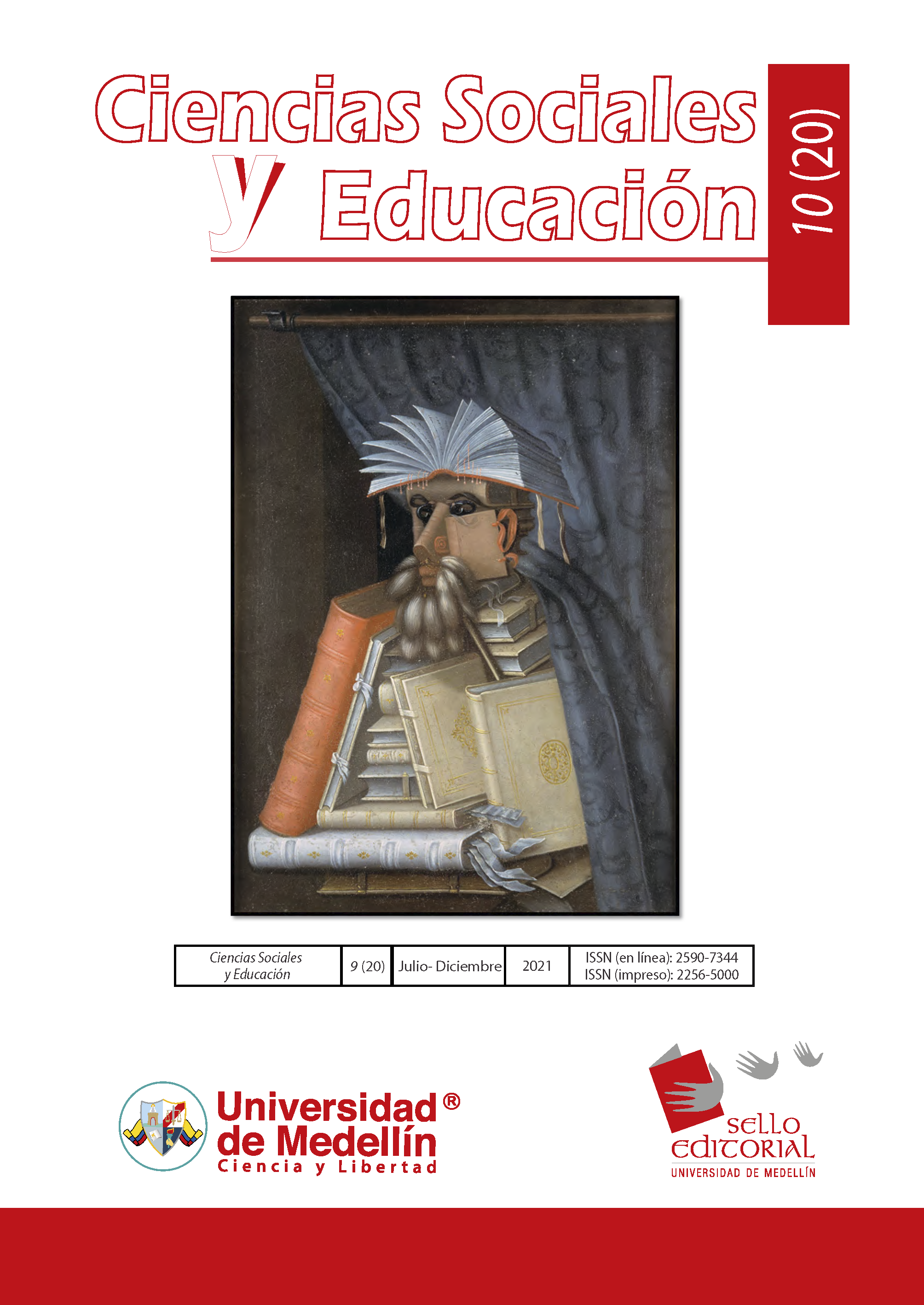Copyright (c) 2021 Ciencias Sociales y Educación

This work is licensed under a Creative Commons Attribution-NonCommercial 4.0 International License.
- Articles
- Submitted: December 14, 2021
-
Published: December 14, 2021
Abstract
Here we evaluate the basic knowledge and at t itude of s tudents in high school about amphibians, and we promote local understanding and perception about this group. We developed two statistical coefficients to be used in the evaluation of the performances of teachers and students. According to the answers of the questionnaire, the knowledge of students about amphibians is nearly null, and hence negative attitudes were detected toward amphibians. Those negative attitudes could be due to the little development of environmental education by families and teachers. The fear to amphibians was detected mostly in girls, although after the class a positive attitude was observed. The statistical coefficients developed here contribute to the evaluation of knowledge in students, allowing teachers to measure how much the students learn.
References
- Batt, S. (2009). Human attitudes towards animals in relation to species similarity to humans: a multivariate approach. Bioscience Horizons, 2(2), 180-190, https://doi.org/10,1093/biohorizons/hzp021
- Cairo, S. L. (2009). Historia de vida, demografía y conservación de las poblaciones más australes del género Melanophryniscus (Anura: Bufonidae) [tesis doctoral, Universidad Nacional del Sur]. Repositorio Digital Institucional de la Universidad Nacional del Sur. http://repositoriodigital.uns.edu.ar/handle/123456789/2933
- Cairo, S., Zalba S. y Nebbia A. (2010). Representaciones sociales acerca de los anfibios en pastizales de Argentina. Su importancia para la conservación. Interciencia, 35(12), 891-896. https://bit.ly/3dOZO3c
- Chyleńska, Z. A. y Rybska, E. (2019). What Can We Do for Amphibians and Reptiles at Schools? Between Personal Conceptions, Conceptual Change and Students’ Pro-Environmental Attitudes. Animals, 9(8), 478. https://doi.org/10.3390/ani9080478
- Ferreira da Silva, R. (2002). Representaciones sociales de medio ambiente y educación ambiental de docentes universitarios(as). Tópicos en Educación Ambiental, 4, 22-36.
- García-Padrón, L. Y. (2021). Diet of a community of frogs in an agroecosystem in western Cuba. Caribbean Herpetology, 76, 1-8. https://doi.org/10,31611/ch.76
- Gibbons, J. (2003). Societal values and attitudes: Their history and sociological influences on amphibian conservation problems. En R. D. Semlitsch (ed.), Amphibian Conservation (pp. 214-227). Smithsonian Institution.
- González-Rancol, Á. y Clairat-Wilson, R. (2016). Los círculos de interés en la orientación profesional para la familia agroindustrial. EduSol, 16(57), 110-121. http://www.redalyc.org/articulo.oa?id=475753137025
- González Alonso, H., Rodríguez Schettino L., Rodríguez A., Mancina C. y Ramos García, I. (2012). Libro rojo de los vertebrados de Cuba. Editorial Academia.
- Hernández Sampieri, R. (2004). Metodología de la investigación. Editorial Félix Varela.
- Kellert, S. R. (1978). Perceptions of animals in American society. En Wildlife Management Institute (comp.), Trans. 43rd North American Wildlife and Natural Resources Conference (pp. 533-546). Wildlife Management Institute.
- Kellert, S. R. (1996). The value of life: Biological diversity and human society. Island Press.
- Ministerio de Educación. (2017). Programa de Biología 2. Octavo grado. Ministerio de Educación, La Habana, Cuba. pp. 30 (Inédito).
- Ministerio de Justicia. (2020, 6 de febrero). Decreto No. 364. Gaceta Oficial n.° 10 ordinaria de 2020. https://www.gacetaoficial.gob.cu/es/gaceta-oficial-no-10-ordinaria-de-2020
- de Oliveira, J. V., de Faria Lopes, S., Duarte Barboza, R. R. y da Nóbrega Alves, R. R. (2018). To preserve, or not to preserve, that is the question: urban and rural student attitudes towards wild vertebrates. Environment, Development and Sustainability, 21(3), 1271-1289. https://doi.org/10.1007/s10668-018-0083-5
- Prokop, P., Medina-Jerez, W., Coleman, J., Fančovičová, J., Özel, M. y Fedor, P. (2016). Tolerance of frogs among high school students: Influences of disgust and culture. Eurasia Journal of Mathematics, Science and Technology Education 12(6), 1499-1505. https://doi.org/10,12973/eurasia.2016.1241a
- Rodríguez Schettino, L. (ed.) (2003). Anfibios y reptiles de Cuba. UPC Print.
- Ruíz García, F. (1987). Anfibios de Cuba. Editorial Gente Nueva.
- Seligman, M. E. P. (1971). Phobias and preparedness. Behavior Therapy, 2(3), 307-320, http://doi.org/10,1016/S0005-7894(71)80064-3
- Semlitsch, R. y Skelly, D. (2008). Ecology and conservation of pool-breeding amphibians. En A. Calhoun y P. de Maynadier (eds.), Science and conservation of vernal pools in Northeastern America (pp.127-147). CRC Press.
- Squeo, F., Arancio, G. y Gutiérrez J. (2001). Libro rojo de la flora nativa y de los sitios prioritarios para su conservación: Región de Coquimbo. Ediciones Universidad de La Serena.
- Stuart, S., Chanson, J., Cox N., Young, B., Rodríguez, A., Fischman, D. y Waller, R. (2004). Status and trends of amphibian decline and extinctions worldwide. Science, 306(5702), 1783-1786. http://www.science.org/doi/abs/10.1126/science.1103538
- Tenti Fanfani, E. (2007). La escuela y la cuestión social. Ensayos de Sociología de la Educación. Siglo XXI.
- Tomažič, I., Pihler, N. y Strgar, J. (2017). Pre-service biology teachers’ reported fear and disgust of animals and their willingness to incorporate live animals into their teaching through study years. Journal of Baltic Science Education, 16(3), 337-349.
- Zamora-Camacho, F. J., Pérez Rivas, M. y Carrillo Rosúa, J. (2018). Experiencias didácticas con anfibios y reptiles vivos y su influencia en las actitudes hacia los mismos de estudiantes de ESO. En C. Martínez Losada y S. García Barros (eds.), 28 Encuentros de Didáctica de las Ciencias Experimentales: iluminando el cambio educativo (pp. 251-256). Universidade da Coruña. https://doi.org/10,17979/spudc.9788497496896




















